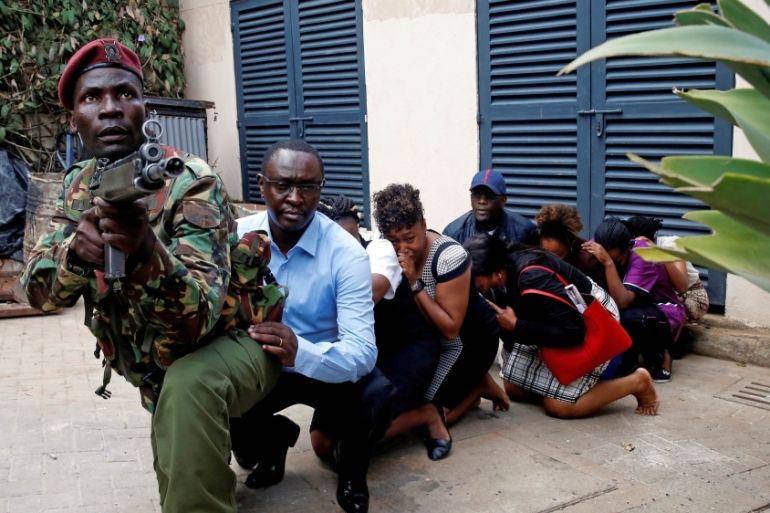Kenyans will be asking tough questions after the Nairobi attack
Al-Shabab has been targeting Kenyan civilians and soldiers for years now. Why have no lessons been learned?

For a third January in four years, Kenya has suffered a terrorist attack organised by al-Shabab terror group. The attack on the DusitD2 Hotel in the heart of Nairobi comes on the third anniversary of the 2016 attack on a base manned by the Kenya Defence Forces (KDF) in the Somali town of El Adde in which 173 soldiers were killed. A year later, in late January, another KDF camp this time in the Somali village of Kulbiyow, was stormed, which resulted in the loss of up to 68 troops.
Yesterday’s attack is also eerily reminiscent of the one on the Westgate Mall in September 2013 in which four al-Shabab terrorists killed 67 people; in fact, it came just a day after a court acquitted one of four men who had been put on trial in connection with the terror act.
In Kenya, memories are also still fresh of the April 2015 siege on Garissa University College, which killed 147 people – the deadliest attack al-Shabab has unleashed so far on Kenyan civilians.
Kenya has been a regular target for the terror group since it invaded Somalia in October 2011. The incursion, code-named Operation Linda Nchi (defend the nation), was undertaken to stop cross-border attacks by al-Shabab militants, but actually paved the way for deadlier and more frequent atrocities.
And for the past almost eight years, Kenyans have felt increasingly insecure as the security apparatus has failed to curb these attacks.
At Dusit Hotel, the response of the Kenyan authorities seemed much swifter and seemingly better coordinated than was the case at Westgate, where the government forces showed up too late and initial rescue efforts were carried out by private individuals.
This time, security officers, including the specially trained police anti-terror unit, the Recce Company, which ended the siege at Garissa University, were on the scene within the hour and rescued a number of people. Buildings around the hotel, including a nearby hostel for university students, were also quickly evacuated.
Nevertheless, the fact that the attack still happened, at the scale and timing that it did (the Kulbiyow was meant to mark the anniversary of El Adde), will raise important questions about the effectiveness of the Kenyan security apparatus’s counterterrorism strategy.
There will be questions asked about the government’s failure to carry out a public inquiry into any of the previous terrorist attacks. “There was never a review meeting on how we handled incidents,” a senior police officer told the Daily Nation in July 2015. “As a result, the police service has basically learnt nothing from [the terror attacks on] Westgate, Garissa, Mpeketoni and others”.
The public will also demand answers about why the attack was not pre-empted. In October, the Kenyan newspaper The Star reported on a leaked police memo, claiming that six al-Shabab operatives were planning to attack targets in Nairobi “between Sunday 28th October 2018 and Sunday 4th November 2018”. There were no terror attacks in that period but initial reports from Dusit suggesting that there were six attackers will raise questions whether it was the same individuals and whether someone dropped the ball on useful intelligence.
There will also be hard questions asked about current pre-emptive tactics being used by the Kenyan security services. Although there is a general acceptance that the government has become better at fighting terrorism, there is still much concern over the disappearance and killing of young men who took advantage of a government amnesty on al-Shabab recruits who wanted to leave the group.
Finally, there will doubtless be questions about the wisdom of continuing to maintain troops in Somalia as part of the African Union Mission in Somalia. Since the 2011 invasion, Kenya has not had a public debate over its objectives in Somalia or the price it is willing to pay to achieve them. The goals of Operation Linda Nchi kept shifting and the mission was wound down and integrated into AMISOM before any of them were achieved. Opposition leader, Raila Odinga, has previously called for the troops to be withdrawn and last year a lawmaker petitioned the National Assembly to demand the same. A 2016 poll found that an overwhelming majority of Kenyans favoured bringing the troops back home but President Kenyatta has said they will stay put until stability is restored. Although AMISOM has announced plans to withdraw by next year, it is unlikely that Somali forces would be able to maintain security without its support, which puts in doubt any such plans.
The President has addressed the nation in the wake of the latest attack and declared victory over the terrorists, just as he did five years ago. But just as then, Kenyan security officials still have plenty of explaining to do.
The views expressed in this article are the author’s own and do not necessarily reflect Al Jazeera’s editorial stance.
